The Definitive Guide to SEO Taxonomy Strategies
-
SEO taxonomy is a system for organizing and categorizing website content to improve user experience and search engine visibility.
-
There are four main types of SEO taxonomies—flat, hierarchical, faceted, and hybrid. Each has its unique advantages and is suitable for different types of websites and content structures.
-
Effective SEO taxonomy implementation requires understanding your audience, organizing content logically, optimizing category pages, using descriptive names, and prioritizing user experience.
-
The main benefits of good SEO taxonomy are improved user experience through intuitive navigation, enhanced search engine crawlability (and indexing), as well as increased search engine rankings and visibility of your content in search results.
-
Regularly auditing and updating your SEO taxonomy is necessary to keep your content relevant and effective. This ongoing process helps you stay aligned with SEO trends and user behaviors, ensuring long-term success.
If you’ve been working in SEO for a while, you might be familiar with the concept of website taxonomy. This refers to how a website’s content is organized and how easily users can find what they’re looking for.
For instance, consider an e-commerce site specializing in clothing. A well-structured taxonomy might include main categories such as Men’s Clothing, Women’s Clothing, and Accessories, with subcategories like T-shirts, Jeans, and Jackets under each.
That being said, site taxonomy is essential for SEO as it directly affects how Google perceives your website and, what’s also highly important, how users navigate it. That’s why focusing on optimizing your site’s taxonomy is an integral step in building a successful site structure.
Disclaimer: This article was initially drafted using SE Ranking’s AI Writer. However, some parts of the text were written from scratch and the content has undergone thorough revisions, editing, and fact-checking by human editors and subject matter experts to ensure accuracy.
What is SEO Taxonomy?
SEO taxonomy refers to the structured classification of a website’s content. It involves organizing information into a logical hierarchy, using keywords and categories to group and label content.
When developing an SEO taxonomy, it’s important to consider the semantic characteristics of the content. This means grouping content not just by related keywords, but by concepts and themes. For example, if a website sells a range of products, the taxonomy might be organized by product categories, with subcategories for specific types or uses.
By using semantic relationships to guide the organization of content, the website can present information in a way that aligns with how users naturally think and search. This not only enhances the user experience but also helps search engines to understand the topic focus and context of the content.
Importance of Site Taxonomy in SEO
A well-executed SEO taxonomy supports a clear and logical site architecture, which is essential for improving a site’s usability and ensuring that users can find the information they need without unnecessary clicks or confusion.
As such, a well-organized taxonomy can improve user engagement metrics, such as time on site and conversion rates.
At the same time, SEO taxonomy is also highly important for search engines.
When your website has a logical structure, it’s easier for search engines like Google to crawl and index your taxonomy pages. This helps them comprehend the context and relevance of your content, which can significantly improve your search engine visibility and rankings.
Plus, a well-organized taxonomy enables search engines to determine the relationships between different content on your site. This improved understanding helps search engines match your content to relevant search queries more accurately. As a result, it can help you drive more targeted traffic to the website.
Moreover, a good URL taxonomy strengthens your internal linking strategy. Effective internal linking allows you to distribute link juice—the SEO value passed from one page to another—more efficiently throughout your site. This helps in ranking individual webpages higher and makes your entire site stronger in the eyes of search engines.
Four Types of SEO Taxonomies
Understanding different types of SEO taxonomies allows you to choose the most effective model for your website. Each type offers unique benefits and suits various types of content and audience needs.
Flat Taxonomies
Flat taxonomy is a straightforward system where all content is organized into categories at the same level without any further subdivision. Each category holds equal weight and there is no hierarchical relationship between them.
Use Case: This taxonomy is perfect for smaller websites or those with a limited scope of content. Such as, a photography blog featuring different types of shoots can maintain a clear and easy-to-use navigation menu with a flat taxonomy structure. Since all categories are on the same level, users can easily browse through them without needing to navigate through multiple layers. This approach works well when the content doesn’t require a complex structure and when simplicity is preferred.

Hierarchical Taxonomies
Hierarchical taxonomy involves a multi-tiered system where content is organized into parent categories and subcategories. This method creates a structured framework that reflects the relationships between different types of content, allowing for a clear, organized presentation.
Use Case: Hierarchical taxonomy is ideal for large and content-rich websites where detailed categorization is necessary. For example, a culinary blog might use a hierarchical taxonomy to organize its content into main categories like Recipes, Ingredients, and Occasions, with corresponding subcategories.
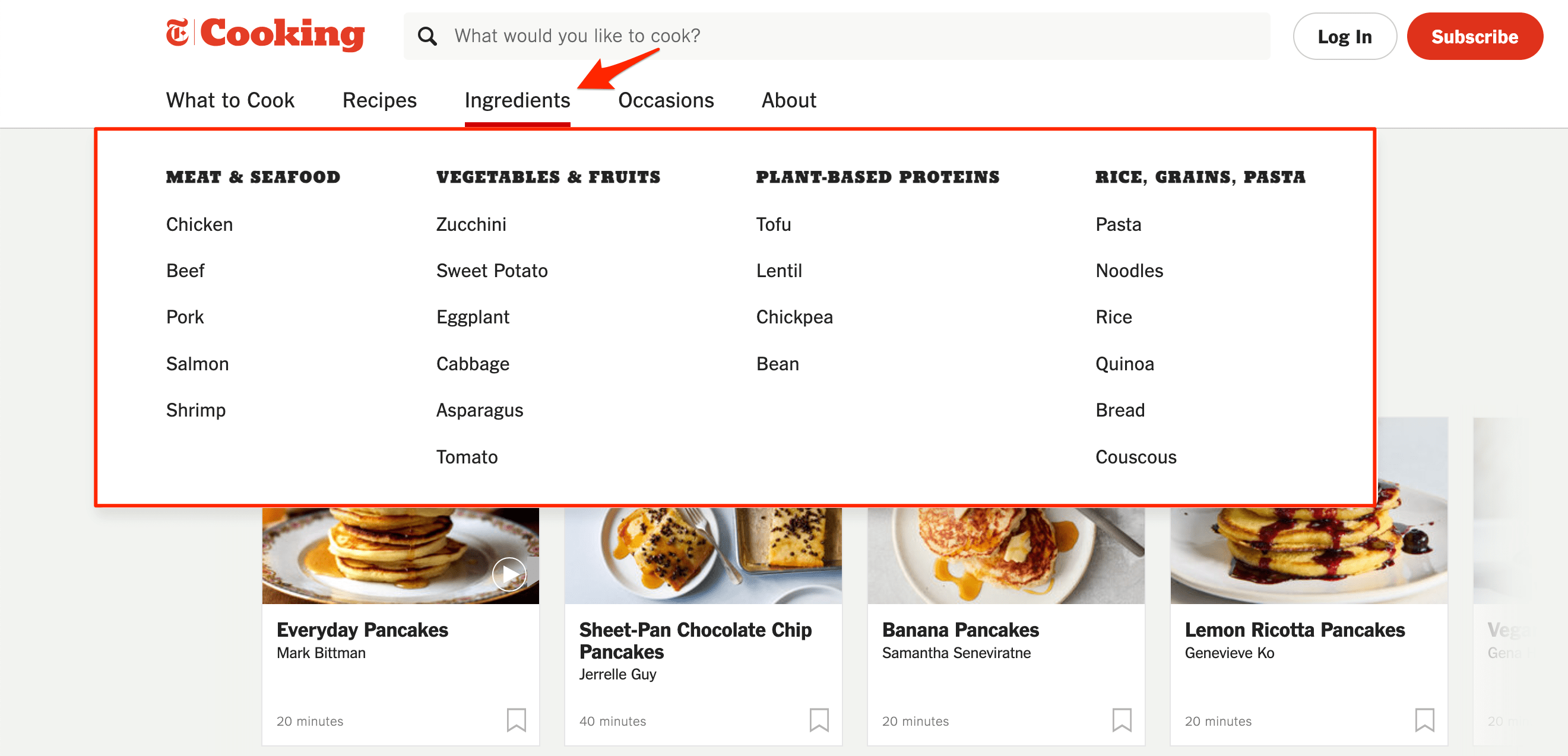
In the screenshot above, Ingredients category features subcategories like Meat & Seafood, Vegetables & Fruits, Plant-Based Proteins, as well as Rice, Grains, Pasta. This structure helps users navigate through extensive content by drilling down from broad topics to more specific ones, enhancing user experience and content discoverability.
Faceted Taxonomies
Faceted categorizes content based on multiple attributes or facets. Users can apply various filters to sort and refine content according to different criteria, such as brand, price, size, or color.
Use Case: This taxonomy is commonly used in e-commerce and large product catalogs where users need to filter and find products based on specific attributes. For instance, an ecommerce website selling clothing might implement faceted navigation to allow users to filter products by features like Color, Price, Size, and Collection. This method helps users quickly narrow down their options and find products that meet their exact needs, improving the overall shopping experience.

Hybrid Taxonomies
Hybrid taxonomy combines elements from multiple taxonomy types to create a flexible and tailored classification system. It integrates aspects of hierarchical, tag-based, and faceted taxonomies to address diverse content needs and provide a customizable organizational structure.
Use Case: Hybrid taxonomy is adaptable to websites with varied content and complex requirements. For example, a retailer of personal care and beauty products might use a hybrid taxonomy that incorporates hierarchical categories for broad content types and faceted navigation for filtering by attributes like brand, concerns, and ingredient preferences. This approach allows for comprehensive content management and enhanced user navigation by offering multiple ways to explore and access content.
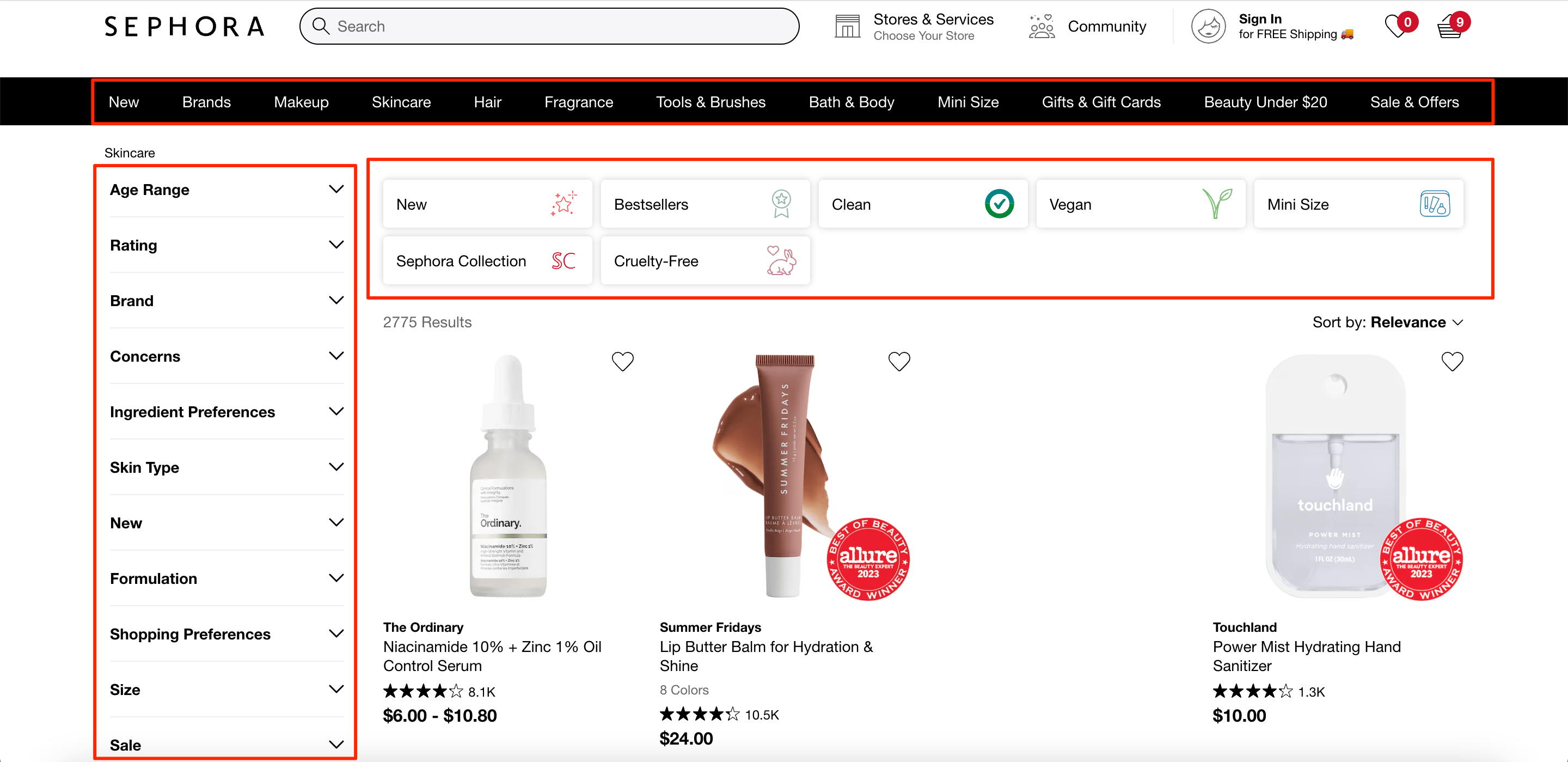
Best Practices for SEO Taxonomy Implementation
Successful SEO taxonomy isn’t just about choosing the correct type based on your site and audience. You must implement it effectively to reap the benefits fully. Here are some best practices to consider.
Understand Your Audience and Their Search Intent
Use tools like Google Keyword Planner or SE Ranking’s Keyword Research Tool to discover the specific keywords and phrases your audience uses. For example, if you run a health and wellness blog, you might find that terms like home workout routines and healthy meal prep are popular.
Then, determine whether users are looking for information, making a purchase, or seeking recommendations. For example, users searching for best budget smartphones are likely in the research phase and seeking product comparisons. This information will help you understand which search intent should you go for within your important website pages.
Finally, using dedicated tools like Google Analytics 4, you’ll be able to study user behavior. Look at metrics such as average session duration and bounce rate to gauge how users interact with your content. Based on collected data, produce relevant content around search terms your audience is interested in.
Organize Content into Categories and Subcategories
Start with high-level categories that encompass major themes. For an online bookstore, categories might include Fiction, Non-Fiction, Science Fiction, and Biography.
During the next step, break down broad categories into more specific subcategories. For instance, under Fiction, you might have subcategories like Mystery, Romance, Thriller, and Historical Fiction. This hierarchical site structure helps users navigate content efficiently and improves SEO by providing clear pathways for search engine crawlers.
Besides, it’s important to reflect your taxonomy in your URL structure. For example, use URLs like example.com/fiction/mystery rather than example.com/category123. Clear, descriptive taxonomies and URL structures enhance user experience and make it easier for search engines to crawl your site.
Optimize Category and Subcategory Pages
To begin with, include relevant keywords within content, title tags, and meta descriptions; ensure that your pages are loading fast; strengthen your internal linking strategy by connecting related categories and subcategories. For instance, on a Cooking Techniques page, you might link to specific subcategories like Baking or Grilling, enhancing both user navigation and SEO.
To evaluate the on-page optimization of your pages, you can utilize SE Ranking’s AI-powered On-Page SEO Checker. This tool highlights and categorizes on-page issues related to metadata, text content, user experience, and more. It organizes these issues into four categories based on their significance and urgency: Errors, Warnings, Notices, and Passed Checks.
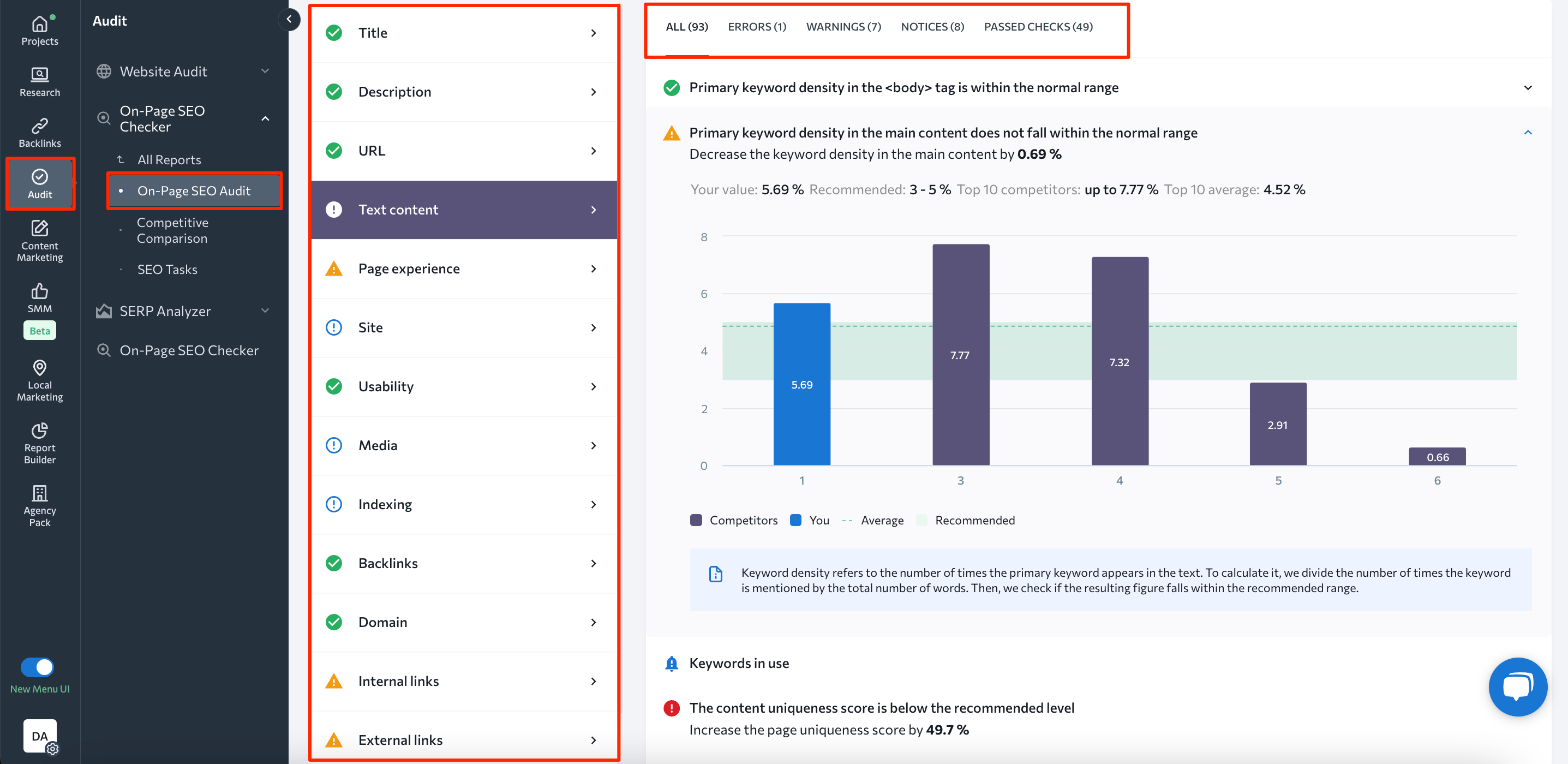
Each identified issue includes a suggested fix, allowing you to enhance your page’s optimization accordingly.
Use Descriptive and Consistent Naming Conventions
Choose names that clearly describe the content. Avoid vague or overly creative names that could confuse users or search engines. Plus, maintain a consistent naming scheme throughout your site. For instance, if you use Men’s Fashion in one category, avoid switching to Men’s Apparel elsewhere. Consistent naming helps site visitors and search engines quickly understand and navigate your content.
Ensure that category and subcategory names are immediately understandable. For example, use Budget Travel Tips instead of Travel Hacks to clearly convey the focus of the content.
To avoid unnecessary edits, establish a consistent vocabulary for page categorization. For example, consistently use e-commerce instead of ecommerce to classify content related to online retail.
Consider User Experience
A well-structured taxonomy should be intuitive, accessible, logical, shallow, and responsive. Categories and subcategories should align with users’ expectations and, as a result, make it easy to find desired content. Clear and descriptive labels, combined with breadcrumb trails, will guide users through the site hierarchy. Moreover, a robust search function, along with visual cues and a consistent layout, further enhances website navigation.
To refine the overall user experience, conduct ongoing usability tests and analyze user behavior data. Optimize the website for mobile devices and ensure it complies with accessibility standards.
For instance, instead of creating multiple levels of categories such as Electronics, Computers, Laptops, and Digital Cameras, you may build a shallower taxonomic structure like Electronics with subcategories like Computers (including laptops, desktops, and all-in-ones) and Cameras (including DSLR, mirrorless, and point-and-shoot).
Regularly Audit and Update Your Taxonomy
Periodically auditing your content and taxonomy allows you to identify areas for improvement, such as adding new categories or merging outdated ones.
A thorough taxonomy and content audit should focus on several key areas:
- Content Relevance: Determine if your content is still accurate, up-to-date, and relevant to your target audience.
- Content Quality: Evaluate the quality of your content, ensuring it is well-written, informative, and engaging.
- Keyword Optimization: Check to see if you’re using appropriate keywords in the titles, descriptions, and body text of your main categories and subcategories.
- Taxonomy Structure: Analyze your category and tag structure to identify any overlaps, gaps, or inconsistencies.
- User Behavior: Examine user data to understand how visitors interact with your content, identifying popular topics and areas for improvement.
Tools like Google Search Console offer valuable insights into user behavior and search queries leading to your category pages. Analyze click-through rates (CTR) for category pages to uncover potential issues with category names or misalignment between user intent and content. Besides, review search rankings for category pages to identify high-performing categories and those requiring optimization.
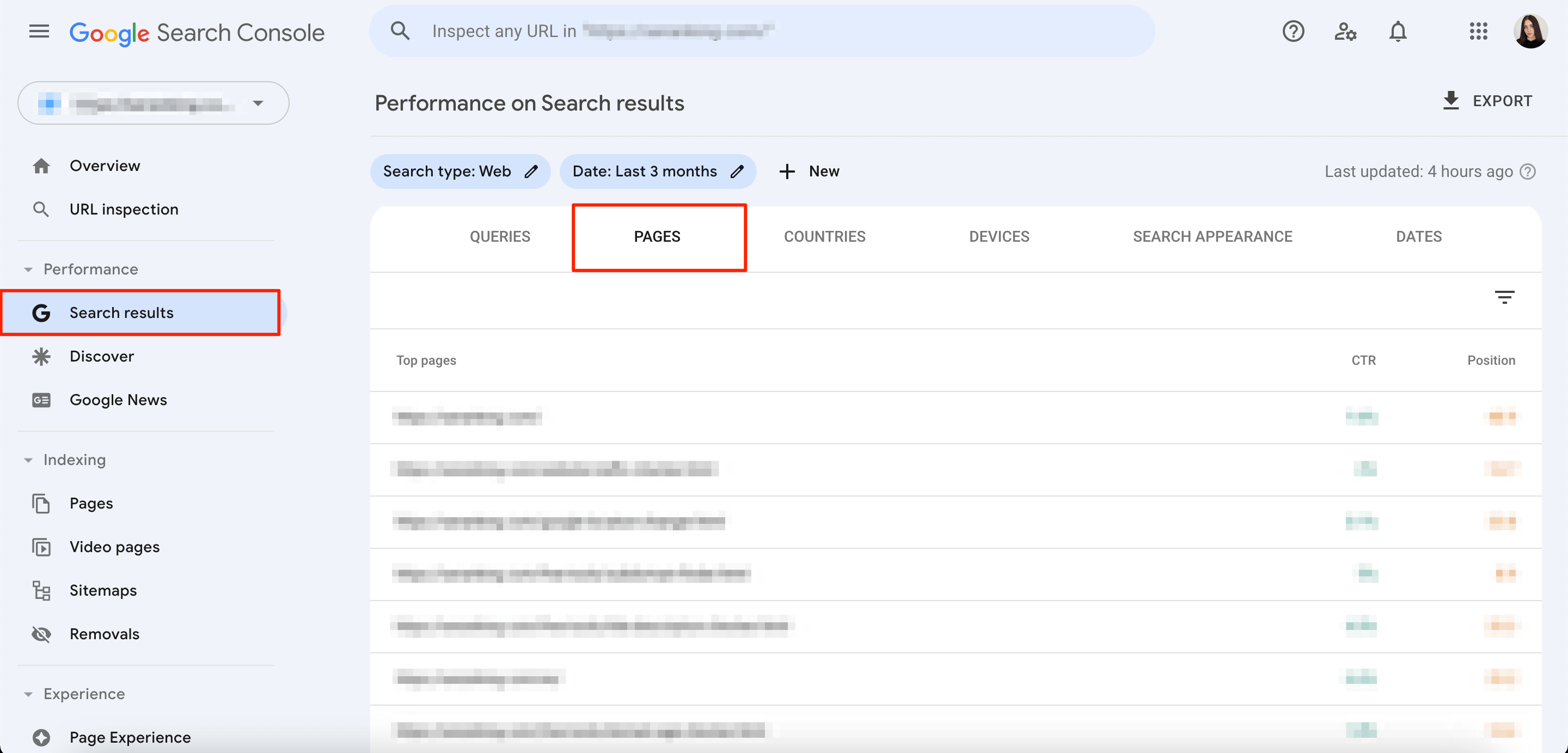
Using GA4, monitor bounce rates to understand why users are leaving category pages and track conversions to measure category page effectiveness in driving desired actions.
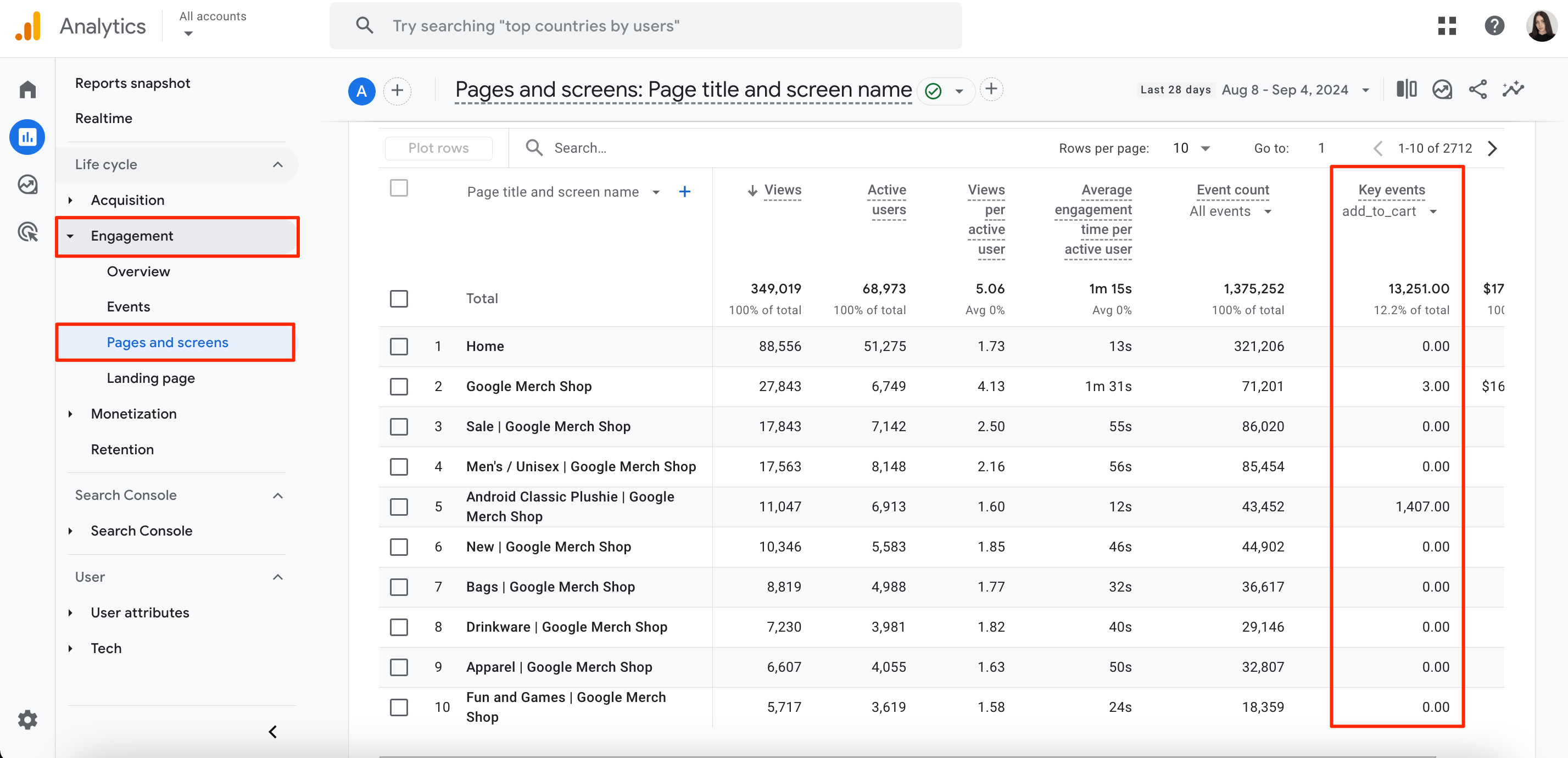
Final Words
In summary, a well-structured SEO taxonomy is a vital element of effective content marketing strategies. By carefully categorizing and organizing information, you can enhance user navigation, improve search engine crawlability, and ultimately achieve higher organic traffic.
Remember, a taxonomy is not a one-time task; it requires ongoing maintenance and adaptation as your website evolves. By investing time and effort into creating a robust taxonomy, you’re laying the foundation for long-term success in your SEO efforts.

